Khalillayev Sherzod A.1, Abdullaev Ikram I.2, Kholmatov Bakhtiyor R.3, Mirzaeva Gulnara S.3
1National University of Uzbekistan, Tashkent, Uzbekistan
2Khorezm Academy of Mamun, Khiva, Uzbekistan
3Institute of Zoology of the Academy of Sciences of the Republic of Uzbekistan, Tashkent, Uzbekistan
Copyright © 2024 The Author(s). Published by Scientific & Academic Publishing.
This work is licensed under the Creative Commons Attribution International License (CC BY).
http://creativecommons.org/licenses/by/4.0/

Abstract
This article presents information on the species composition of insects and their bioecological features in the mountainous and foothill areas of the Surkhandarya region, located in the south of Uzbekistan. During the research in the Surkhandarya region, 54 species belonging to 38 genera of Orthoptera were identified. In natural landscapes, including mountainous and foothill areas, 28 species were found, 24 in cotton fields, 24 in corn fields, 19 in gardens, 18 in legume fields, and 12 in wheat fields. Three species are common in agrocenoses: Dociostaurus maroccanus, Calliptamus italicus italicus and Locusta migratoria migatoria, so it is very important to regularly monitor their numbers. Information on the diversity and number of Orthoptera species in different agrocenoses is at the highest level in June-August and on some of their bioecological features.
Keywords:
Orthoptera insects, Family, Genus, Species, Larva, Imago, Natural landscapes, Agrocenosis
Cite this paper: Khalillayev Sherzod A., Abdullaev Ikram I., Kholmatov Bakhtiyor R., Mirzaeva Gulnara S., Taxonomic Species Composition of Orthoptera Insects (Insecta: Orthoptera) in Mountain and Sub-Mountain Regions of Surkhandarya Region and Their Distribution in Agrocenoses, International Journal of Genetic Engineering, Vol. 12 No. 6, 2024, pp. 131-137. doi: 10.5923/j.ijge.20241206.13.
1. Introduction
Orthopterans are widespread in almost all climatic regions, from tropical and subtropical regions to the vastness of Western Siberia. Some species prefer to live near water bodies in mountainous areas with dense grass. Other species have always attracted researchers as components of rare shrubs and herbs in desert and semi desert regions [6]. Orthopterous insects have always been attractive to researchers as a component of different Central Asian landscapes [1,4,6,8]. Orthoptera in the agrocenoses of the southern part of the Aral Sea area were investigated by G.Sh. Shamuratov [7] and M.K. Childebayev [3]. No special research has been made in the Orthoptera in the southern areas of Uzbekistan in the last 25 years.
2. Materials and Methods
The Orthoptera research was carried out between April and August 2023. We inspected the following areas in the insects’ habitats: a wheat field; a wheat field after the wheat had been removed; an orchard; a corn field; a cotton field; a beet field; an orchard with alfalfa as; a bean field; and natural landscapes. During insects collection the tracks were recorded using GPS receivers.The insects were collected as described in the standard protocol proposed by F.N. Pravdin [5]. We accepted the following abbreviations for the specification of a species’ abundance: sg – single insects found (1-3 individuals per hour); rr – a rare species (4-10 inds/h); cm – a common species (11-20 inds/h); fr – a frequently occurring species which, however, does not form swarms (21-100 inds/h).
3. Results and Discussion
The information on the studied areas, brief characteristics and the quantitative data analyses regarding the collected individuals of Orthoptera are provided in Table 1. In the Baysun District the insects were collected from 7 different stations, Sherabad District – 6 stations, Angar, Termez and Denau Districts – 3 stations each. We also collected the insects in Kumkurgan and Saryasiya Districts. We determined the number of insects (males, females and larvae) collected in an hour. We also specified their species composition. Table 1. The place, time and conditions in which the insects were collected, and their quantitative figures
 |
| |
|
The research data established that the total number of individuals collected in the course of the study was 1,275 (Table 1), with 682 (53,6%) females, 390 (30,3%) males, and 293 (15,9%) larvae. The ratio of females to males was 1,7:1,0. In spring the largest portion of the insects is composed of larvae. So, the insects collected between 24 and 26 April comprised over 50% of larvae. Their natural development into mature forms leads to the reduction of their numbers towards summer. Species that breed several times a year produce larvae in summer time, too. The abundance of Orthoptera species varied across the stations. Baysun district showed the largest figure, with 100 individuals collected for 1 hour in an orchard on June, 18. Also, large numbers of the insects were caught in the corn field of Sherabad district (August 21), in the cotton fields of Angar district (June 20; August 22) and in the cotton fields and orchard of Jarkurgan district (August 23). The natural landscapes of Termez (August 22, 13 inds/h) and Baysun (August 21) districts yielded the smallest number of the insects. The largest number of Orthoptera species (17) was recorded in a fruiting orchard in Jarkurgan district and a mung bean field in Saryasiya district on 29 June. The smallest number of species was recorded in Termez (August 22) and Baysun (April 24) districts. In the course of the research we have identified 54 Orthoptera species belonging to 38 genera (Table 2).Table 2. The species composition and abundance of Orthoptera in agrocenoses and adjoining natural sites in Surkhandarya province
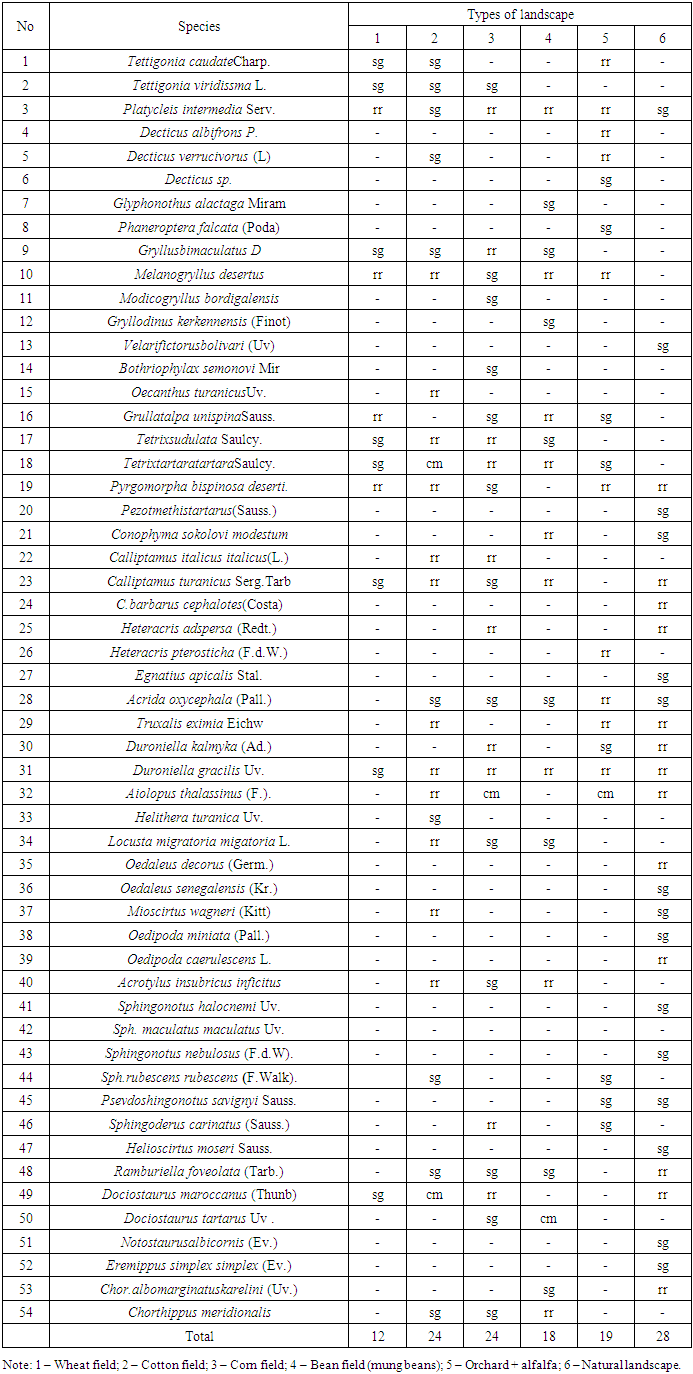 |
| |
|
Totally, 12 Orthoptera species were recorded in the wheat fields, with 4 predominating species: Pyrgomorpha bispinosa deserti (larvae, imago), Melanogryllus desertus (larvae, imago), Grullatalpa unispina (larvae, imago) and Platycleis intermedia (larvae). As the wheat had been removed, the number of species reduced to 8 because of the migration of species Tettigonia caudate, Tettigonia viridissma, Tetrix sudulata, Tetrix tartara tartara, Melanogryllus desertus, and Grullatalpa unispina. The cotton fields were characterised by a much more diverse of Orthoptera species composition. In the cotton field of Angar District 9 species were recorded in spring (April 26), 16 species in early summer (June 20) and 15 species in late summer (August 22). In total, 24 species were recorded. In early April, the predominating Orthoptera species in Angar District were Tetrixtartaratartara (22,9%), Acrotylus insubricus (12,6%), Pyrgomorpha bispinosa deserti, and Melanogryllus desertus (11,6% each). In early summer, the predominating species was Dociostaurus maroccanus (21,7%). In late August, species Aiolopus thalassinus, Platycleis intermedia, Oecanthus turanicus, Truxalis eximia, and Duroniella gracilis predominated in the cotton fields of Angar District (Table 3).Table 3. The numbers of Orthoptera recorded in the cotton field. Angar District, April 22, 2023. Inds/h.Coordinates: N 3724′56.4., E 06709′59.3
 |
| |
|
A corn field in Sherabad District was examined. The results of the examination are provided in Tables 1, 2 and 3. The insects were collected in the specified territories on April 25, June 19 and August 21. In spring the predominating species were Dociostaurus maroccanus (20,5%), Pyrgomorpha bispinosa deserti, and Tetrix sudulata (11.7% each). By early summer, the number of species grew from 11 to 16. Apart from Moroccan locust, other predominating species were Sphingoderus carinatus, Duroniella kalmyka and Pyrgomorpha bispinosa deserti (Table 4). By late August, the number of species dropped from 16 to 12. Imago of Aiolopusthalassinus (30,0%), Calliptamus italicus italicus (11,6%) and Heteracris adspersa (10%) predominated. In total, 24 Orthoptera species were recorded in the corn field. Table 4. The numbers of Orthoptera recorded in the corn field, Sherabad District, June 19, 2023. Inds/h.Coordinates: N 3738′37.1., E 06700′48.2
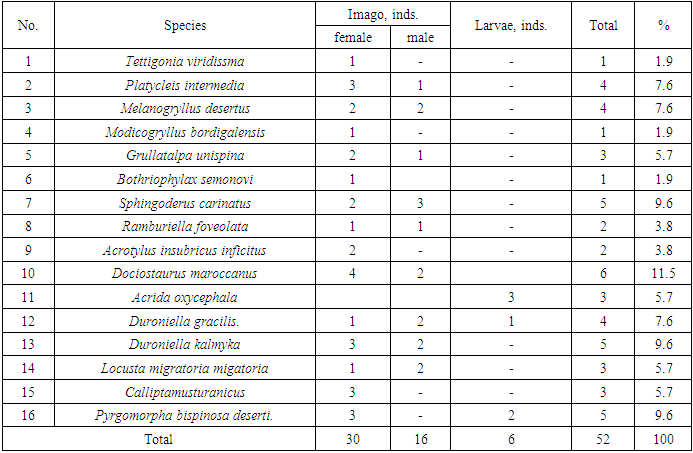 |
| |
|
In Saryasiya Districts a mung bean field was studied. In late June 62 individuals were collected and 17 species of Orthoptera were recorded (Table 5). The insects across the field were only on an imago stage. The predominating species were Dociostaurus tartarus, Duroniella kalmyka (12,9% each) and Melanogryllus desertus (11.2%). Totally, 18 species were recorded in the mung bean field. Table 5. The numbers of Orthoptera recorded in the mung bean field, SaryasiyaDistrict,June 29, 2023. Inds/h.Coordinates:3825′59.3., E 06756′02.3
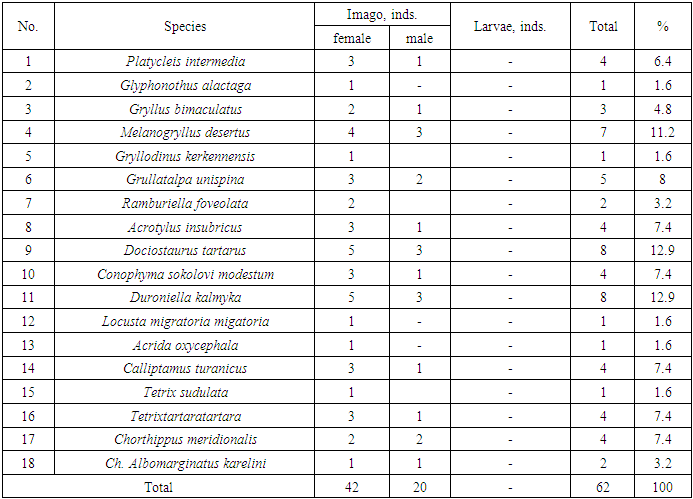 |
| |
|
In Denau District two orchards with alfalfa in the undergrowth were inspected. In addition, orchards in Baysun and Jarkurgan Districts were studied, and the species composition of Orthoptera established. The number and species composition of Orthoptera in the orchards with alfalfa were almost identical to those in ordinary orchards. In general, 19 Orthoptera species were recorded.The species that predominated the orchard with alfalfa in Denau District comprised Aiolopusthalassinus (16,6%), Pyrgomorpha bispinosa deserti (11,6%), Truxalis eximia, and Platycleis intermedia (10% each) (Table 6). The most numerous species of the ordinary orchard in Jarkurgan District were Pyrgomorpha bispinosa deserti (13,1%), Heteracris pterosticha and Platycleis intermedia (11,4% each).Table 6. The numbers of Orthoptera recorded in the orchard with alfalfa as undergrowth. Denau District. 24 August 2023. Inds/h. Coordinates: N 3816′14.5., E 06755′42.6
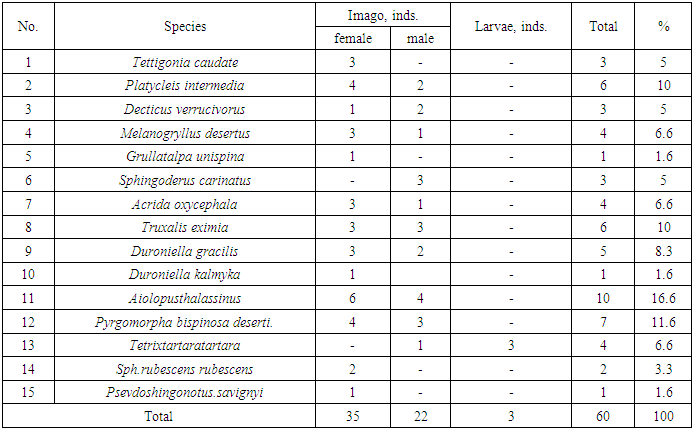 |
| |
|
7 sites with natural landscapes in Baysun, Sherabad and Termez Districts were examined for Orthoptera. The natural sites were characterised by a great abundance of the insects and a wide range of species, with a total of 28 species recorded in this type of territory (Table 1 and 2). Table 7 provides data on the numbers of Orthoptera recorded in the reed beds of Sherabad District. In this district we recorded 13 species. The predominating ones were Aiolopus thalassinus (17,7%), Duroniella gracilis, and Heteracris adspersa (11.1% each). Table 7. The numbers of Orthoptera recorded in natural landscapes. Reedbeds, Sherabad District, August 22, 2023. Inds/h. Coordinates: N 3754′22.0, E 06703′21.7 (0.4 inds/m2)
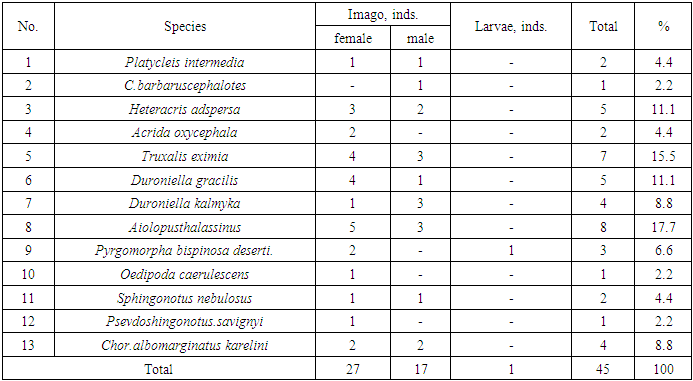 |
| |
|
Our research demonstrated that natural landscapes featured the greatest diversity of Orthoptera (28 species), followed by cotton and corn fields (24 species each), orchards (19 species), a mung bean field (18 species) and a wheat field (12 species). The following species compositions were recorded in different types of landscape in Karakalpakstan: cotton fields – 29 species, wheat and rice fields – 11 species each, melon fields – 8 species, orchards with alfalfa – 7 species and fallow fields – 3 species by Childebayev et al. [3]. In South-West Tajikistan 26 species were recorded in cotton fields, 4 in wheat fields and 24 in alfalfa fields by Chernyakhovsky [2].
4. Conclusions
The Orthoptera species that predominated the studied sites were Platycleis intermedia, Oecanthus turanicus, Melanogryllus desertus, Heteracris adspersa, Truxalis eximia, Duroniella gracilis, Duroniella kalmyka, Aiolopusthalassinus, Pyrgomorpha bispinosa deserti, Dociostaurus tartarus, Dociostaurus maroccanus, and Calliptamus italicus italicus. The last two species are swarming locusts that tend to cause serious damage of various cultivated plants. Favourable weather conditions may lead to a sudden and considerable rise in the numbers of these insects, which may pose a serious threat to agricultural lands. Large numbers of Italian locust were recorded in alfalfa fields in South-West Tajikistan and various agrocoenoses in Karakalpakstan by M.Ye. Chernyakhovsky (1982) and M.K. Childebayev et al. (2011). The presence in the agrocoenoses of three swarming species, Moroccan, migratory and Italian locusts, makes it necessary to control their numbers on a regular basis. The species diversity and numbers of Orthoptera in agrocoenoses are highest in June and August.Orthoptera species from 38 genera in various agrocoenoses and adjoining natural sites in Surkhandarya province were identified. There were 28 species found in natural landscapes, 24 in cotton fields, 24 in corn fields, 19 in orchards, 18 in mung bean fields, and 12 in wheat fields. The species diversity and numbers of Orthoptera in agrocoenoses were highest in June and August. The presence in the agrocoenoses of three swarming species, Moroccan, migratory and Italian locusts, makes it necessary to control their numbers on a regular basis.
References
| [1] | Bekuzin A. A. The Locust Fauna of the Sultan-Uizdag Range and Adjacent Areas // Bulletin of the Karakalpak Department of the Academy of Sciences of the UzSSR, 1962, 1(7), PP. 84-91. |
| [2] | Chernyakhovsky M. Ye. The Formation of the Locust Fauna in the Agrocoenoses of South Tajikistan // The Formation of the Animal and Microbial Population in Agrocoenoses. Thesis of a Report at an All-Union Meeting, Moscow, Puschino, 1982. PP. 62-63. |
| [3] | Childebayev M. K., Nurzhanov A. A., Medetov M. Zh. Orthopterous insects (Insecta: Orthoptera) in the agrocoenoses of Karakalpakstan (Uzbekistan) // Almaty. Kazakh National Agrarian University, 2011. PP. 76-83. |
| [4] | Ergashev N. Ye. The Orthoptera of the Karshi Steppe. Biology, Species Composition, Ecology and Distribution // Tashkent: Fan, 1982. 75 pages. |
| [5] | Pravdin F. N. The Ecological Geography of Insects in Central Asia. – Moscow: Nauka, 1978. 270 pages. |
| [6] | Sergeyev M. G., Bugrov A. G. Orthoptera in the agrocoenoses of South-West Tajikistan. Preliminary Report // Anthropogenic Impacts on Insect Communities. Novosibirsk, 1985. PP. 134-138. |
| [7] | Shamuratov G. Sh., Kopaneva L. M. 1984. Acridoidea in Karakalpakia // Nukus, Karakalpakstan, 112 pages. |
| [8] | Tokgayev T. B. 1972. The Fauna and Ecology of Acridoidea in Turkmenistan // Ashkhabad: Ylym, 224 pages. |


 Abstract
Abstract Reference
Reference Full-Text PDF
Full-Text PDF Full-text HTML
Full-text HTML





